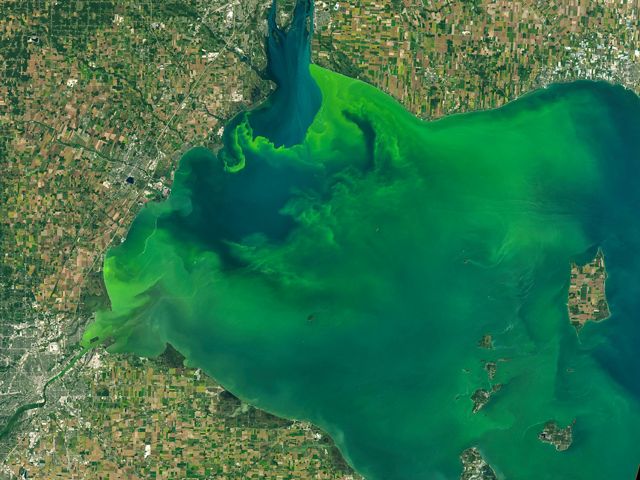Clean Water Victory!
H2Ohio Water Fund and other initiatives mark turning point in addressing algal blooms.
For several years, TNC and its partners championed and helped shape a statewide program to improve water quality for Ohio. In 2019, the H2Ohio program became a reality and in 2021, it received a second appropriation for $168 million, continuing to signal that H2Ohio and improving water quality for Ohio is a priority for this administration. Funding to advance nature-based solutions, such as restoring wetlands, has resulted in dozens of new projects in northwest Ohio and this year the program expanded to the Ohio River Basin. TNC works closely with the Ohio Department of Natural Resources to help prioritize where these restoration projects should occur to achieve the greatest long-term impact.
Read more about H2Ohio fiscal year 2021 accomplishments here.
It was fall of 2015 when Tracy Freeman first caught wind of the idea that today represents the defining moment in her career. She was new to her job as The Nature Conservancy’s government relations director in Ohio, and there was talk around the proverbial water cooler about how to establish a steady stream of funding to address the state’s harmful algal bloom problem.
The situation was serious. Just one year prior, in 2014, the city of Toledo had issued a “Do Not Drink” advisory for residents. The algae-clogged waters of Lake Erie’s western basin had produced the growth of dangerous toxins, leaving 500,000 in the Toledo area without drinking water for several days.
As news of the tragic event spread worldwide, environmentalists and farmers alike knew the tipping point had come—the state of Ohio officially had a water crisis on its hands.
Harmful Algal Blooms Have Gotten More Prevalent and Severe
Harmful algal blooms aren’t a new occurrence for Ohio. Since the late 1990s, the rate and severity of blooms has been increasing steadily.
“The Clean Water Act of 1972 made a huge difference in curbing pollution from factories and sewers,” says Freeman, who prior to working for TNC spent 15 years in the Ohio Environmental Protection Agency’s Office of Legislative Affairs. “But in recent history, other sources of water pollution have become the primary concern.”

Many factors contribute to the increased incidence and extent of harmful algal blooms. Culprits include fertilizer and manure runoff from agricultural lands, exacerbated by a changing climate and an increase in intensity and volume of precipitation.
A Statewide Health and Economic Problem
While Lake Erie’s harmful algal blooms may be the most infamous, the problem affects lakes and rivers across the state, including the Ohio River, which in 2015 had a bloom more than 600 miles long. The increase in blooms not only poses serious threats to human health and wildlife, it also impacts our economy. For example, researchers at The Ohio State University estimate that algal blooms at Grand Lake St. Marys and Buckeye Lake cost Ohio homeowners $152 million in lost property value over six years.
Despite the magnitude of the problem, Freeman says that when she started her role with TNC, there was no substantial dedicated funding to address these issues. “There was a lot of diverse money coming in as ‘random acts of conservation’ from different state and federal sources,” she says. “But nothing that could be counted on over the long term.”
The Water Fund Solution
So TNC developed an idea to create a new program that would provide longterm, science-based funding to activities that were not getting the support they needed. Freeman says she recognized early on that change was going to have to be achieved politically. For that to happen, stakeholders would first need to present a unified front. She quickly set about doing just that.
For several years, Freeman, alongside partners representing vast interests, worked hard to achieve alignment and rally together around a water fund concept that TNC helped to shape. The big break came in 2018, when gubernatorial candidate Mike DeWine took a meeting with TNC.
“He was definitely interested in the idea,” Freeman says. “Especially given that stakeholders like the Ohio Farm Bureau were behind it, too.”
Freeman says that while Governor DeWine’s enthusiasm was encouraging, she is amazed by how quickly the idea came to fruition, given all the years spent lining up support. Just a half a year later, in July, with the stroke of a pen, Governor DeWine signed into law the H2Ohio Water Fund.
H2Ohio will provide $172 million for water quality improvement projects over the next two years, including $46 million in the first year for nature-based solutions, such as creating and restoring wetlands and floodplains—for which TNC advocated strongly. In addition, after this two-year period, Governor DeWine’s budget authorizes half of any surplus in the state’s General Revenue Fund to be allocated to H2Ohio projects, which TNC is helping to identify under the leadership of the Ohio Department of Natural Resources.
Freeman is pausing only momentarily to let the achievement soak in. “In TNC fashion, we don’t rest on our laurels,” she says. “There’s definitely more to be done—especially since H2Ohio wasn’t funded in the state’s budget at the level initially proposed.”
Long-Term Funding is Still Needed
While the establishment of H2Ohio creates huge opportunities for addressing harmful algal blooms, Freeman says we need to acknowledge next steps—especially through the Senate passage of House Bill 7, which would create a perpetual trust to fund H2Ohio. At the same time, Freeman says we need to expedite the adoption of sustainable agriculture practices. This includes improving soil health and nutrient management on farms, restoring floodplains and wetlands and implementing water management tactics like two-stage ditches and retention ponds.
“Our solutions to this problem need to be practical and effective—both politically and on the ground, where people with various vested interests are trying to do the right thing to improve our water quality,” Freeman says. “I’m thankful to be in a position to help achieve that.”
You Can Help
Our work isn’t finished! Only through sustained effort will we secure Ohio’s water quality for future generations.

